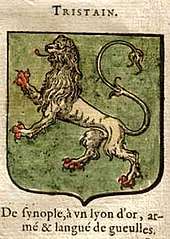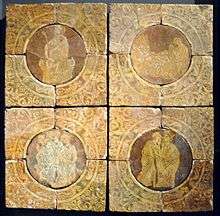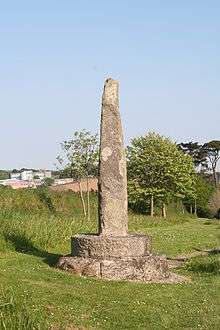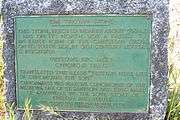Tristan
Tristan (Latin/Brythonic: Drustanus; Welsh: Trystan), also known as Tristram or Tristain and similar names, is the hero of the legend of Tristan and Iseult.
| Tristan | |
|---|---|
| Tristan and Iseult character | |
.jpg) Tristán e Iseo (La vida) by Rogelio de Egusquiza (1912) | |
| In-universe information | |
| Title | Sir |
| Occupation | Knight of the Round Table (Arthurian branch of his legend) |
| Spouse | Iseult of Brittany |
| Significant other | Iseult of Ireland |
Tristan legend cycle

In the story of Tristan and Iseult, Tristan is the son of Blancheflor and Rivalen (in later versions Isabelle of Cornwall and Meliodas), and the nephew of King Mark of Cornwall, sent to fetch Iseult back from Ireland to wed the king. However, he and Iseult accidentally consume a love potion while en route and fall helplessly in love. The pair then undergo numerous trials that test their secret affair, before the tragic end.
Tristan made his first recorded appearance in the 12th century in British mythology circulating in the north of France and the Kingdom of Brittany, which had close ancestral and cultural links with Wales and the English counties of Cornwall and Devon by way of the ancient British kingdom of Dumnonia, as made clear in the story itself, and the closely related Cornish and Breton languages, both of which are P-Celtic like Welsh. Although the oldest stories concerning Tristan are lost, some of the derivatives still exist. Most early versions fall into one of two branches: the "courtly" branch represented in the retellings of the English poet Thomas of Britain and his German successor Gottfried von Strassburg, and in the Folie Tristan d'Oxford; and the "common" branch, including the works of medieval French literature. The name Tristan is also known as "Trischin" in the Maltese culture.
Arthurian romancier Chrétien de Troyes mentioned in his poem Cligès that he composed his own account of the story; however, there are no surviving copies or records of any such text. In the 13th century, during the great period of prose romances, Tristan en prose or Prose Tristan became one of the most popular romances of its time. This long, sprawling, and often lyrical work (the modern edition takes up thirteen volumes) follows Tristan from the traditional legend into the realm of King Arthur where Tristan participates in the Quest for the Holy Grail. Its great success spawned Italian (such as the Tavola Ritonda) and other rewrites. Among these was the French Post-Vulgate Cycle that combined it with a shortened version of the Vulgate Cycle, elements of which itself had been earlier used in the Prose Tristan.
In the 15th century, Thomas Malory shortened and incorporated the Prose Tristan into his own English-language The Book of Sir Tristram de Lyones (The Fyrste and the Secunde Boke of Syr Trystrams de Lyones), a part of Le Morte d'Arthur in which Tristan plays the role of a counter-hero to Lancelot.[1] In Malory's telling, Sir Tristram (Tristan) had met and fallen in love with Isolde (Iseult) earlier. His uncle, King Mark, jealous of Tristan and seeking to undermine him, appears to seek marriage to Isolde for just such a hateful purpose, going so far as to ask Tristram to go and seek her hand on his behalf (which Tristram, understanding that to be his knightly duty, does). Of all the knights, Tristram most resembles Sir Lancelot as he too loves a queen, the wife of another. Tristan is even considered to be as strong and able a knight as Lancelot, including the fulfilment of Merlin's prophecy for them two to engage in the greatest duel between any knights before or after, although neither kills the other and they become beloved friends. Because of King Mark's treacherous behaviour, Tristram takes Isolde from him and lives with her for some time, but he then returns Isolde to him. Nonetheless, Mark kills Tristram while he is "harping" (Tristan is noted in the book as one of the greatest of musicians and falconers).
Historical roots

There are obscure aspects to Tristan; his ancient Brittonic name appears to mean "clanking swords of iron", while the more recent Romance languages version, including French, is interpreted as "sadness" in keeping with the Tristan and Iseult romantic tale. Tristan could also derive from the legendary Pictish Chronicle Drest or Drust which frequently appears as the name of several ancient Pictish kings in modern Scotland far to the northwest; Drustanus is merely Drust rendered into Latin. It may have originated from an ancient legend regarding a Pictish king who slew a giant in the distant past, which had spread throughout the isles, or the name may also come from a 6th-century Pictish saint who bore another form of the name – or it may have migrated upwards from the southwest due to the fame of the legends of Arthur. In addition, there was a Tristan who bore witness to a legal document at the Swabian Abbey of Saint Gall in 807.
Béroul's Norman French Romance of Tristan and Iseult, possibly the earliest extant version,[2] is notable for its very specific geographical locations in Cornwall. Another strange aspect is his kingdom, Lyonesse, for whose existence there is no evidence. However, there were two places called Leonais: one in Brittany, the other the Old French transcription of Lothian. However, the Isles of Scilly have also been proposed to be this place, since they were possibly one island until Roman times and several islands are interconnected at low tide. Regardless, Tristan being a prince of Lothian would make his name more sensible, Lothian being on the borderlands of the Pictish High-Kingship (and once was a part of Pictish territory; Tristan may in fact have been a Pictish prince under a British king). There are also records of a Turstan Crectune, whose name gave the Lothian village of Crichton its name. He was granted lands in 1128 by King David I of Scotland. One other suggestion is that he could have been adopted into the family of Mark of Cornwall, a historical practice attested in Roman law.
Researcher Sigmund Eisner came to the conclusion that the name Tristan comes from Drust, son of Talorc, but that the legend of Tristan as we know it, was gathered together by an Irish monk living in North Britain around the early 8th century.[3] Eisner explains that Irish monks of this time would have been familiar with the Greek and Roman narratives that the legend borrows from such as Pyramus and Thisbe; they would also have been familiar with the Celtic elements of the story such as The Pursuit of Diarmuid and Gráinne. Eisner concludes that "the author of the Tristan story used the names and some of the local traditions of his own recent past. To these figures he attached adventures which had been handed down from Roman and Greek mythology. He lived in the north of Britain, was associated with a monastery, and started the first rendition of the Tristan story on its travels to wherever it has been found."[4]
The Tristan Stone

Possible evidence for his roots in South West England is the 6th-century inscribed granite pillar known as The Tristan Stone, or The Longstone (Cornish: Menhir, meaning long stone), set beside the road leading to Fowey in Cornwall. It measures some 2.7 m (7 feet) in height and has been set in a modern concrete base. Until the 1980s it was in its original position some yards from the coastal road in a field near the turn down to the small harbour of Polkerris. It was then closer to Castle Dore and may have been the origin of the association of this site with the story of the tragic love of Tristan and Iseult. There is a Tau cross on one side and a Latin inscription on the other side, now much worn, reading:[5]
DRVSTANVS HIC IACIT
CVNOMORI FILIVS
[Drustanus lies here, son of Cunomorus]

It has been suggested, and is confidently asserted on the plaque by the stone, that the characters referred to are Tristan, of which Drustan is a variant, and Cynvawr Latinized to Cunomorus. Cynvawr, in turn, is said by the 9th-century author Nennius, who compiled an early pseudo-historical account of King Arthur, to be identified with King Mark known in alias 'QVONOMORVS'. Around 1540, John Leland recorded a third line now missing: CVM DOMINA OUSILLA ('with the lady Ousilla': Ousilla is conceivably a latinisation of the Cornish Eselt), but missed the badly weathered first line ('DRUSTANVS HIC IACIT') which has led Craig Weatherhill to speculate that this third line could have been lost by stone fracture,[6] but which has also led Goulven Peron to propose to see 'OUSILLA' as a particular reading of 'DRUSTANVS'.[7]
Modern works
- From 1857 to 1859, Richard Wagner composed the opera Tristan and Isolde, now considered one of the most influential pieces of music of the 19th century. In his work, Tristan is portrayed as a doomed romantic figure.
- Algernon Charles Swinburne wrote an epic poem Tristram of Lyonesse.
- The legend of Tristan has been represented through the song of the same name by English singer-songwriter Patrick Wolf, and was the lead single from his 2005 album, Wind in the Wires.
- Tristan plays a prominent role in the comic book series Camelot 3000, in which he is reincarnated in the year 3000, as a woman and subsequently struggles to come to terms with his new body, sexuality and identity, reconciling them in turn with his previous notions of gender roles.
- In 1983, Russian composer Nikita Koshkin wrote a classical guitar solo entitled "Tristan Playing the Lute", evoking the spirit of Tristan from the legend of "Tristan and Isolde", initially set in a playful adaptation of traditional English lute music.
- In The Warlord Chronicles novel series by Bernard Cornwell, Tristan is the young heir to Kernow and the son of King Mark. He is best friend of the protagonist Derfel Cadarn and a loyal ally of Arthur. Eventually however, in an agonising decision for the sake of peace and out of his deep belief in royal legitimacy, Arthur betrays Tristan and Iseault when they seek refuge and leaves them to be killed by King Mark.
- In the 2004 film, King Arthur, based on the Sarmatian connection theory of origin for the Arthurian legends, Tristan (Mads Mikkelsen) is a prominent member of the knights, who are Sarmatians serving under a half-Roman Arthur in the 5th century. Tristan is a cavalry archer, able to make amazing shots with his Parthian/Eurasian-style reflex composite bow. He uses a Chinese sword and holds true to the style, armour and weapons, of a Sarmatian mounted archer. After many injuries, he dies a heroic death at the hand of the Saxon king Cerdic in single combat at the Battle of Badon Hill.
- The 2006 film Tristan & Isolde starred James Franco as Tristan, Thomas Sangster as the child Tristan and Sophia Myles as Isolde, written by Dean Georgaris and directed by Kevin Reynolds.
- The 2008 TV show Merlin depicts Tristan and his partner Isolde as smugglers in the Season 4 finale "The Sword in the Stone" parts 1 & 2. They help Arthur, Merlin, and the Knights regain Camelot after Morgana takes over. In the end, Isolde is killed by Helios, Morgana's henchman, but nothing is said of what happens with Tristan.
- In the mobile game Fate/Grand Order (2015), Tristan is an Archer class servant.
- In the novel The Rise and Fall of D.O.D.O. (2017), one of Tristan's escapades inspires the legend of St. Tristan.
- One of the main character's in James Herriot's series All Creatures Great and Small (franchise), Tristan Farnan, works as a veterinary surgeon.
- In the video game Age of Empires II HD: The African Kingdoms, Tristan featured as a hussar.
See also
- Auchinleck manuscript
- Palamedes
- Medieval hunting (terminology)
References
- https://www.jstor.org/stable/43345583
- Fedrick, Alan S. (1970). The Romance of Tristan. Great Britain: Penguin Classics. p. 9. ISBN 0-14-044230-8.
- Sigmund Eisner, The Tristan Legend, A Study in Sources, Northwestern University Press, Chicago, 1969, pp. 37, 52.
- Sigmund Eisner, The Tristan Legend: A Study in Sources, Northwestern University Press, Chicago, 1969, p. 37.
- Megalithic Portal
- Craig Weatherhill, Cornovia, Ancient sites of Cornwall & Scilly 4000 BC – 1000 AD Halsgrove, Wellington, 2009 p. 88.
- Goulven Peron, Tristan et Yseut ont-ils existé ? Publication de l'Observatoire Zetetique 77, 2013 (fr) ; see also, by the same author and on the same subject (the names DRUSTANUS and OUSILLA on the Long Stone of Fowey) : L'origine du roman de Tristan, Bulletin de la Société Archéologique du Finistère, CXLIII, 2015, pp. 351–370 (fr).
External links
| Wikimedia Commons has media related to Tristan and Iseult. |